► Ferrari’s Roma takes on super-GTs
► V8 vs flat-six and V12
► Which is best out in the wilderness?
Fast cars are for going places, not round in circles on a track. Which storied European marque builds the best GT? Ferrari’s new Roma has to battle the explosively fast Porsche 911 Turbo S and Aston Martin DB11 AMR.
Pre-flight briefing: Ferrari Roma
Why is it here?
Ferrari’s gorgeous new 2+2 sits alongside, rather than above or below, the drop-top Portofino. They share similar spec and price, but as a lighter coupe the Roma promises to put the ‘sport’ into ‘Sports GT’. Ferrari claims as much as 70 per cent of the body and structure is different from the Portofino. No convertible gubbins means a stiffer structure and a 100kg weight saving, too. The Roma actually runs softer spring rates.
Any clever stuff?
A big change over the Portofino is the Roma’s transaxle, modified from the SF90’s. With eight gears, it’s 6kg lighter than the Portofino’s seven-speed ‘box. The Roma also gets Ferrari’s steering wheel-mounted manettino control (and, less successfully, touch-sensitive pads to control infotainment menus).
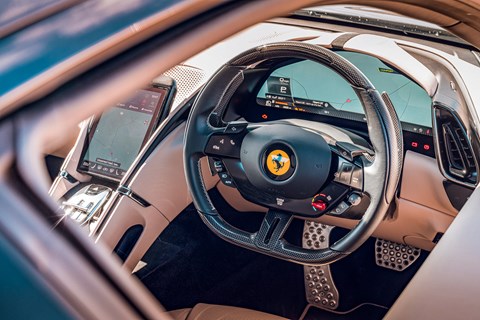
Which version is this?
There’s only one Roma, but you can option it up to the eyeballs. This example features £60k worth of extras – including a special-order colour (‘Blu Roma’ – £7104), a carbon rear diffuser (£6720) and Magneride Dual Mode Suspension (£3168).
Read our Ferrari Roma review
Pre-flight briefing: Porsche 911 Turbo S
Why is it here?
Porsche’s 992 Carrera already has a twin-turbo flat-six, so the Turbo S has gone turbo-tastic to stand out: it’s bored out to 3.75 litres and boosted to 641bhp. At £156k it’s the most expensive model in the 911 range (but still undercuts the Roma by 15 grand).
Any clever stuff?
Four-wheel drive and four-wheel steer, plus clever active aero, with a new, movable front spoiler and rear wing increasing downforce by 15 per cent. The S gets Porsche active suspension (PASM), active anti-roll (PDCC) and carbon-ceramic brakes as standard.
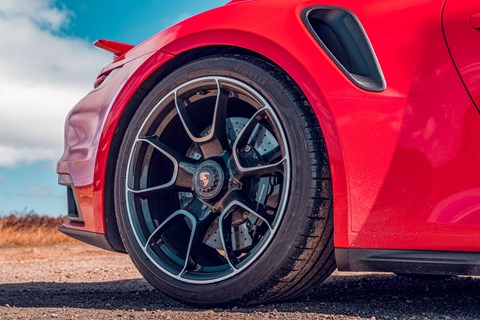
Which version is this?
Priced £22k over the standard Turbo, the S gets you an extra 70bhp, 7mph on the top speed (up to 205mph) and a 0.1sec advantage to 62mph. Like the Turbo, the S is only available with the eight-speed PDK gearbox. It’s a steep premium to pay but if sales data for the previous 911 Turbo is anything to go by, few buyers will opt for the base, non-S Turbo. And even fewer will resist splurging on the options list; £312 for colour-coded seatbelts, anyone?
Read our Porsche 911 Turbo S review
Pre-flight briefing: Aston Martin DB11 AMR
Why is it here?
Because there’s nothing quite as glamorous as an Aston 2+2 GT, and the DB11 is the latest in a long line of them. Just as pretty as its forebears and far faster, the DB11 is a great benchmark. Well, mostly great. The DB11 launched in 2016 but criticism of its dynamics led to this AMR version effectively taking over from the standard V12 in 2018, with a tweaked chassis, lighter wheels and an extra 30bhp (not that it was weedy before).
Any clever stuff?
The DB11 uses clever hidden aero to avoid a big wing. One sweet detail is the Aeroblade, which draws air into the car’s C-pillar and channels it through ducts to exit from a slot in the bootlid, creating downforce. ‘Curlicue’ vents cut into the front wheelarches release high-pressure air, cutting lift in the process.
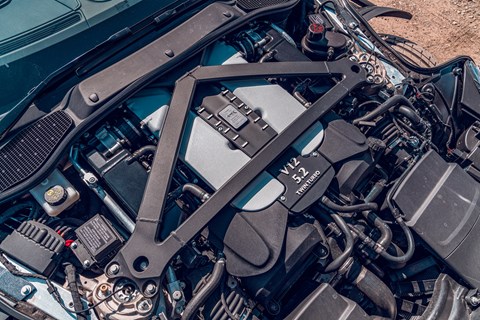
Which version is this?
There are three DB11s: the V8 coupe (that’s just had its power upped to 528bhp); a V8 Volante droptop; and the AMR, the 630bhp V12 flagship, priced at £178k. All come with an eight-speed auto gearbox. This example has £20k of options, like the lime green brake calipers (£1995).
Aston Martin DB11 AMR: the long-term test
European Super League: Roma vs GT rivals
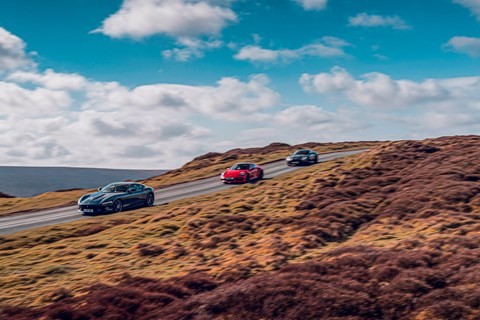
Crest the brow of the hill in third, and inside my brain I say: ‘Oh. My. God.’ It’s just too perfect: perfect car, perfect weather, no traffic – and look at that sweeping, towering, blockbuster stretch of road ahead! Oh. My. God.
Even as a journalist on a car magazine, moments like this are surprisingly rare. Within these pages we like to dress it up a bit – you know, sell the dream. In reality, you’re often in an Aventador while logjammed in traffic outside Aylesbury, or stuck behind a tractor at 20mph. We tend to gloss over all that.
But today, I promise, the dream has become reality. I’m in a Ferrari Roma on the North Yorkshire Moors, the sun is just going down and the white lines are looking particularly crisp against the dark grey tarmac. The road ahead is unbelievable, and right now it’s all mine.
Third is the best gear in the Roma: third and fourth, between 4000rpm and the 7500rpm redline, are just magnificent. So squeeze down on the long throttle pedal and feel that instant pulse of power surge through the whole car, scooping you up and plunging you down this majestic sweep of road. A red shift-light on the Ferrari steering-wheel rim blinks and you pull the right-hand paddle. The transmission jolts into fourth, and the Roma pours on yet more speed, the V8 filling the cabin with a growl of pure power and potency.
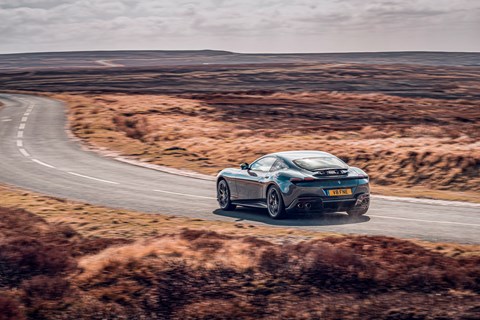
This road isn’t billiard-table smooth, and the Roma is fiddling about on the surface – tiny jinks and twitches, tweaks of directional change as the suspension finds its way. But with that dancing around the messages channelled through the seat and the steering are unequivocal: ‘Everything’s in hand,’ the car is saying. You drive the Roma with an utter conviction it’s under your command.
The road isn’t dead straight, either: it curves and snakes its way over this empty landscape, each slower, unsighted corner or brow quickly unfurling to offer yet more open views. For mile after mile, bend after bend, I’m charging – utterly absorbed, carving lines with the delicate, communicative steering. Everything that was ever compelling or rewarding about driving a car is here.
By the time I’ve cooled down and I’m coasting back to the hotel I’m convinced the Ferrari has won this test.
A little unfair, I’ll grant you, given the other two cars don’t even arrive until the next morning…. but there you have it, my verdict. However, tradition – not to mention the editor – dictates that I really ought to drive the other two cars.
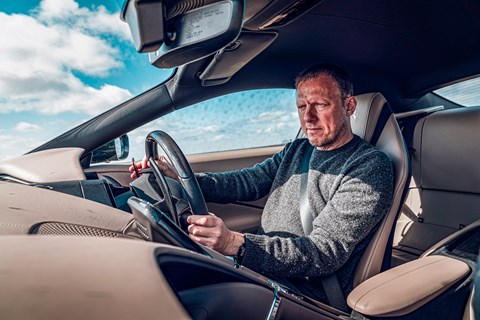
Okay, okay. Where was I?
The North Yorkshire Moors. We chose this bleak but beautiful part of the north because it’s a decent drive from CAR HQ and this is a test of sports GTs, after all. So next morning, high on the moor, I meet with Jake Groves, who’s feeling fresh and enthusiastic after his early-morning blast up the A1 in the Aston Martin DB11 AMR.
In many ways, this Aston is the Roma’s closest rival: a svelte 2+2 grand tourer from a blue-chip sporting brand; packing 630bhp to the Ferrari’s 611bhp; a 208mph top speed versus 199mph; and a price tag of £178,500, against the Ferrari’s base price of £170,659 (though this Roma is optioned to £220k!). Of course, the AMR DB11 offers the added cachet of a 5.2-litre twin-turbo V12, whereas the Roma has a V8… and there’s no denying a V12’s supremacy in the Top Trumps of life.
But to look at? The DB11 is normally a head-turning car, sophisticated and muscular, and in blacked-out AMR guise it has a pleasing degree of menace too. But beside the Roma? I can tell you, in the metal the Roma is absolutely, head-spinningly drop-dead gorgeous from any angle. Beside it, the DB11 looks a little ungainly, with fussy details. The Ferrari just nails the tailored elegance, the lithe athleticism of the sports GT. In its proportions and its swept-back Riva-speedboat style it proudly evokes the 250 GTO and Daytona; but in its detailing – like those tail lights, set into a folded crease – the Roma is wonderfully bang-up-to-date.
‘What an amazing car,’ Jake says of his Aston as he hands me the keys. ‘So fast and effortless this morning, cruising up the motorway.’
‘Whatever,’ I scoff. ‘Wait until you drive the Ferrari.’
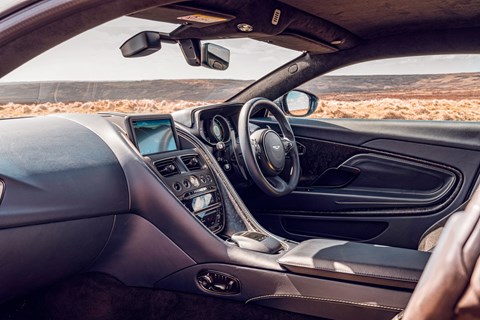
If the exterior already has the Aston on the back foot, things get worse when I climb in. This interior has aged fast. I know the Ferrari is spanking new and the DB11 is five years old, but the pace of digital change means the Aston feels three generations old. The buttons, the screen, even the air vents look like they’re out of a 20-year-old Jaguar XK8. The seats feel wider at the shoulders and less supportive, and some of the interior styling… I find myself looking at the passenger door, at the cheap handle and a round speaker that looks like it’s from Halfords, thinking, ‘This is £180,000?’
Things get better when you start that V12. It barks into life with a savage snarl, and the tickover has a keener edge compared to the Ferrari’s rumbling V8. Pull away, and the DB11’s not short on speed either: Aston gives a 0-62mph time of 3.7 seconds, compared to the Ferrari’s 3.4. Aston also says 516lb ft is available from just 1500rpm. On the road, it doesn’t feel so instantaneous; the V12 feels like it needs winding up, compared to the amazing, lag-free response of the Ferrari. Once you do get the V12 stoked, it is an epic engine, one that’ll squeeze you into your seat all the way to that 630bhp peak at 6500rpm. All with the added soundscape of a popping and crackling V12.
But – and I’m afraid there is a ‘but’ – dynamically the Aston is nowhere. And no, that’s not just me. Jake also gets out of the Ferrari after a short drive with a sad look: ‘Yes, okay, the Roma’s on a different level,’ he admits.
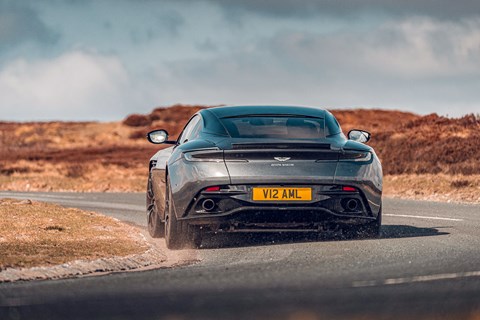
Sad, because we want the Aston to be better. The original DB11 was criticised for its wayward body control and soft rear axle. In 2018 the AMR version tightened everything up, but today in a straight fight the Aston lacks the poise or precision to compete with the Roma’s composure. When you press on, the DB11 starts to feel like a much heavier car, with long, lazy rebounds bouncing you around after a bump. At 1870kg it is heavier than the Ferrari (at 1570kg), but weight isn’t the problem. The chassis is just messier – there’s body movement in all directions and the steering doesn’t bite like you want it to. The Aston simply can’t pivot into a corner as convincingly as the Roma. The AMR chassis has three settings – GT, Sport and Sport+ – and I try all three. On this challenging moorland road, GT is awful, and while Sport and Sport+ are stiffer, the essential body control problem isn’t fixed. It means you can’t fling the DB11 into a corner; you hold back, because you don’t trust it.
There will be Aston fans out there shouting at this page: ‘It’s a GT, not a supercar! It’s designed for long drives in comfort!’ True – but during the test I drive both cars on the motorway too, and the Ferrari can also play the GT role better.
By the time I return to our moorland layby, art director Mal Bailey has arrived in the Porsche. Finished in Guards Red with optional centre-lock wheels (20-inch on the front, 21 rear), I can’t take my eyes off it. It’s a different take on the 2+2 GT: a familiar ’60s outline again (the 911 silhouette is still beautiful) but where the Roma is shark-nosed and graceful, the 911 looks like a bruiser, brawny and squat, the sloping roof and swollen arches making it look like a bullfrog about to leap.
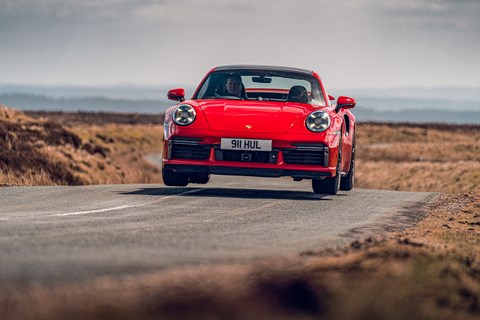
This is the Turbo S, its twin-turbo flat-six bored out to 3.75 litres, with improved air intakes and bigger turbos to boost power from the standard Turbo’s 572bhp to a mighty 641bhp at 6750rpm. It’s the only car here with all-wheel drive and at £155,970 it’s the cheapest too. Though options mean this example comes in at nearly £173k.
When I open the Porsche’s door it’s another setback for the Aston Martin. This is how you do an ultra-modern GT interior: deeply supportive half-leather sports seats with a cool chequered fabric; minimal buttons, lots of gloss black, big touchscreens; and a wide-open ambience, created by the dashboard’s bold horizontal lines. It’s not flashy, but it exemplifies modern, informal luxury.
On start-up the engine has a recognisable flat-six chatter and whirr. Again, there are different driving modes and I set off in Normal. Straight away, the suspension is the hardest of the three – I wouldn’t say harsh, because the edges of the potholes are rounded off, but it’s bumpy enough to have you jigging around in your seat.
In Normal mode the engine is surprisingly quiet and it’s a pussycat at low speeds – it may do 205mph but the Turbo S is still an everyday supercar. But we’re not here to waft along, so I twist the drive mode selector on the steering wheel to Sport and press the M button for manual paddle changing. The exhaust immediately blurts out a deep drainpipe gurgle, and as I pick up the pace the S reveals what a monster it is.
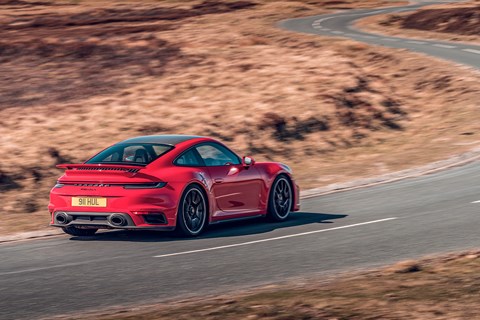
Flat-out in the first three gears is shocking – an unruly shove, a neck-straining, blood-draining lunge that requires you to lean your body forward to keep your head upright. The sound is incredible at higher revs – it yowls like a mournful jazz trumpeter. Not a single ounce of power or torque is wasted – no wheelspin, no drama, just sudden forward propulsion. Porsche claims 0-62mph in 2.7 seconds, but beyond that third, fourth and fifth continue to pull hard, making serious speeds like 140mph readily accessible. I would imagine.
Beneath you, all kinds of technology is at work: there’s four-wheel steering, active suspension, anti-roll control, torque vectoring and active aero – but these are all subtle interventions. All you feel is the total mastery of the car’s movements – no roll, no pitch, no understeer, no oversteer, just crisp, linear progress.
Likewise the controls. The brakes are the best here, giant ceramics with huge calipers and a well-judged pedal. The steering is laser accurate but always fluid, never twitchy – the Turbo S flows, despite that bumpy ride, allowing you to lean into the stupendous grip.
But – yes, I’m afraid there’s a ‘but’ – there’s very little feel in it. This is why a back-to-back test is so useful. If you were to drive the Turbo S alone, it would be a triumph; but after the Ferrari, the way the 911 moves feels one-dimensional. Porsche 911s were once known for being alive with sensations, a constant ebb and flow of input and feedback. Not the Turbo S – all the organic movements have been engineered out in the name of speed. It’s just a machine for setting indecent lap times.
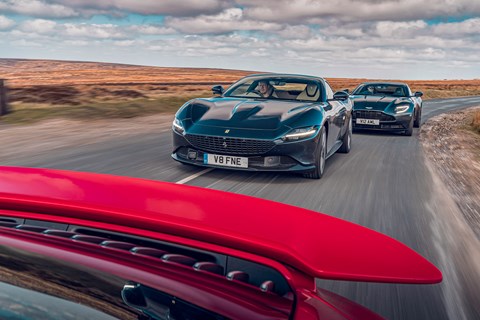
I return to the Ferrari, wondering if it can beguile me once again with its magic. Climbing in, its interior seems a tad chintzy after the Porsche, full of fiddly chrome details and a touchscreen in the middle that looks like an afterthought. The 911 is the resounding interior winner.
But grip the Roma’s fat and curvaceous carbonfibre wheel (£2880), press start and turn the manettino to Sport. On the move, the Ferrari concedes nothing, even to the outrageous 911. The 3.9-litre V8 is mighty: related to the mid-engined F8’s, it shares that car’s renowned throttle response. Best paddleshift of the trio, too.
But the way it rides at speed is its real ace card. Such is its inherent poise, even in Comfort the Roma feels great. In Sport, the suspension still absorbs bumps better than the 911, but you feel every movement, texture and camber. And compared to the Porsche’s vacuum-suction-to-the-road, the Roma feels deliciously daunting and formidable at speed – not scary, because the sense of control is so gratifying, but you do need to get your game face on. It doesn’t insulate you, as it bobs and wriggles and dances over the surface – it needs controlling, needs steering, needs sensitivity. And when it all comes together… oh my god, it’s bliss.
Second opinion: Jake Groves, deputy news editor
You’re drawn in by the Aston’s charm and flexible V12. But it feels old inside and struggles on these testing roads. The 911, meanwhile, crushes the road into submission, powered by an engine that feels like it was built by SpaceX. It’s the beautiful Roma, though, that feels truly alive. I was shrieking with delight as the Roma danced from corner to corner on its tiptoes. Although I told Mark that the 911 would be the car to take home at the end of a long day’s testing, simply because the Ferrari’s infotainment is so infuriating, it’s the Roma, not the 911, that I’m desperate to drive again.
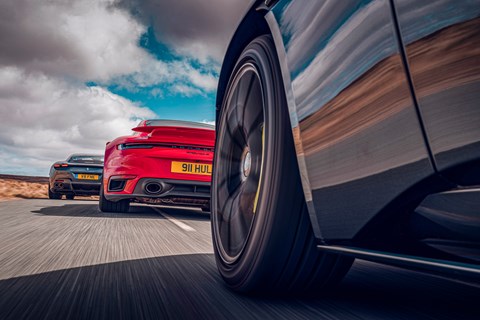
Second opinion: Mal Bailey, art director
Gun to my head, I’d go with the Porsche. For me, the Aston feels old and lacks handling finesse. But I’ll give it a point for being the best sounding car here.
The Roma is amazing, though I’m not 100 per cent sold on the looks and, if I were in the market for a Ferrari I’m not sure I’d choose this Ferrari. But if you’re buying a Porsche then the 911 Turbo S needs to be near the top of your list – phenomenally fast and assured. Yes, it lacks feel. But the 911 Turbo S makes me feel like the best driver in the world – which I can confirm is not the case.
Roma vs GT rivals: the final reckoning
So I was right then, the Ferrari wins.
Some readers won’t care – they just want the DB11 regardless, for its speed, its V12 and all that James Bond cultural appeal. Fair enough. But be in no doubt, the DB11 is outclassed in this company. The progress made in 2018 when the AMR replaced the original V12 has been comprehensively overtaken now, and the DB11 badly needs updating. According to Aston’s new boss that will happen soon, but until then it struggles to reach the bar the other two cars in this test set so high. Sure, you can drive the AMR up a motorway and revel in its power and torque (and that noise), but on twistier roads it just doesn’t have the poise of the Porsche and Ferrari.
The 911 is a sterner challenge to the Ferrari, and I understand why Mal and Jake (though the latter has since changed his mind…) both wanted to take the Turbo S home: the way it looks, that interior, the solid dependability. If you can live with the jiggly ride, it’s a car that can burble through town, cruise up the motorway, park in Tesco… its everyday domesticity always hiding the monster lurking within. But the Turbo S feels like it’s been designed to go fast with minimal input from the driver – like it’s had all the touchy-feely engagement dialled out of it.
Whereas the Roma… Some people will think they could just never see themselves posing in a Ferrari GT, with all those Monaco harbour overtones. But all that ‘dolce vita’ stuff doesn’t do the Roma justice. It is gobsmackingly beautiful, yes; but it combines those looks – along with the comfort and class of a GT – with the dynamic abilities of a mid-engined supercar. Like a mid-engined Ferrari, it does that spooky confidence thing to you: despite the 600bhp, the prancing horse badge and the astronomical price, you just get in and razz for all you’re worth, because you can feel it’s with you, beneath you, benign and urging you on. As grown-up as you need it to be, but also eager, willing and consummately capable when you’re in the mood to play around.
Forget the Portofino and any shared DNA – I mean, nice car, but not a milestone Ferrari. The Roma is a truly great Ferrari, a memorable one, whether it’s on the North Yorkshire Moors or stuck in traffic in Aylesbury.
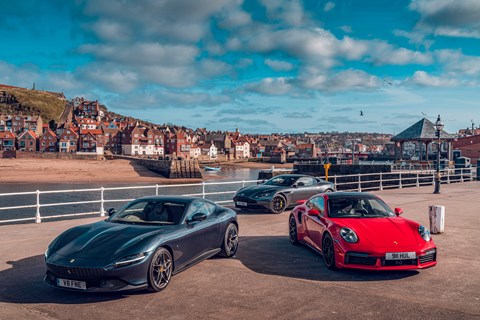
Ferrari Roma vs 911 Turbo S vs DB11 AMR: the verdict
First place: Ferrari Roma
Few will remember the Portofino in years to come; but the Roma is one of the great Ferraris
Second place: Porsche 911 Turbo S
Devastatingly quick, the Turbo S is a mighty GT that trades in excitement more than engagement
Third place: Aston Martin DB11 AMR
In isolation it’s a magnificent V12. In this company the DB11 is outclassed
Read more CAR comparison tests here